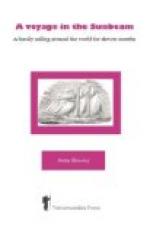We had not long left the town before our men began to undress each other; for their clothes were so tight that it required no inconsiderable effort to remove them. Some of them were beautifully tattooed. My wheeler had the root of a tree depicted on one foot, from which sprang the trunk and branches, spreading gradually, until on his back and chest they bore fruit and flowers, amongst which birds were perched. On his other leg was a large stork, supposed, I imagine, to be standing under the shadow of the same tree. Another man had human figures tattooed all over him, in various attitudes.
[Illustration: A Drag across the Sand in a Jinrikisha.]
In less than an hour we reached the narrow strip of land which at low water connects the island or peninsula of Inoshima with the mainland. This isthmus was covered with natives gathering shells and seaweed, casting their nets, and pushing off or dragging up their boats; whilst an island rose fresh and green from the sea, with a background of snowy mountains, stretching across the bay, above which Fujiyama towered grandly. This name signifies ‘not two, but one mountain,’ the Japanese thinking it impossible that there can be another like it in the world. The lovely little island is called Inoshima, and is conical in shape and covered with evergreens and Buddhist temples, with a few small fishing villages scattered on its shores. We walked right across it in about an hour; so you may imagine it is not very large. The sea teems with curiously shaped fish and beautiful shells. The staple food of the inhabitants seems to be those lovely ‘Venus’s ears,’ [17] as they are called—a flattish univalve, about as big as your hand, with a row of holes along the edge, and a lining of brilliant black mother-of-pearl. These were lying about in heaps mixed with white mother-of-pearl shells, as big as your two fists, and shaped like a snail-shell.
[Footnote 17: Haliotis.]
[Illustration: Inoshima by a Japanese Artist.]
Our jinrikisha men deposited us at the bottom of the main street of the principal village, to enter which we passed through a simple square arch of a temple. The street was steep and dirty, and consisted principally of shell-fish and seaweed shops.
An old priest took us in hand, and, providing us with stout sticks, marched us up to the top of the hill to see various temples, and splendid views in many directions. The camellias and evergreens on the hillside made a lovely framework for each little picture, as we turned and twisted along the narrow path. I know not how many steps on the other side of the island had to be descended before the sea-beach was reached. Here is a cavern stretching 500 feet straight below high-water mark, with a shrine to Benton Sama, the Lucina of Japan; and having been provided with candles, we proceeded a few hundred feet through another cave, running at right angles to the first.




